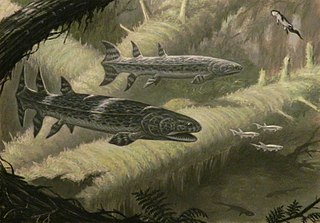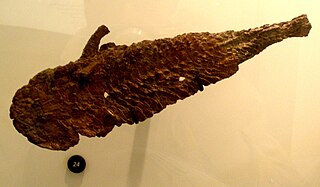
Dunkleosteus is an extinct genus of large arthrodire ("jointed-neck") fish that existed during the Late Devonian period, about 382–358 million years ago. It was a pelagic fish inhabiting open waters, and one of the first apex predators of any ecosystem.

Hynerpeton is an extinct genus of early four-limbed vertebrate that lived in the rivers and ponds of Pennsylvania during the Late Devonian period, around 365 to 363 million years ago. The only known species of Hynerpeton is H. bassetti, named after the describer's grandfather, city planner Edward Bassett. Hynerpeton is known for being the first Devonian four-limbed vertebrate discovered in the United States, as well as possibly being one of the first to have lost internal (fish-like) gills.

Hyneria is a genus of large prehistoric predatory lobe-finned fish which lived in freshwater during the Devonian period (Famennian).

Bothriolepis was a widespread, abundant and diverse genus of antiarch placoderms that lived during the Middle to Late Devonian period of the Paleozoic Era. Historically, Bothriolepis resided in an array of paleo-environments spread across every paleocontinent, including near shore marine and freshwater settings. Most species of Bothriolepis were characterized as relatively small, benthic, freshwater detritivores, averaging around 30 centimetres (12 in) in length. However, the largest species, B. rex, had an estimated bodylength of 170 centimetres (67 in). Although expansive with over 60 species found worldwide, comparatively Bothriolepis is not unusually more diverse than most modern bottom dwelling species around today.
Edward B. 'Ted' Daeschler is an American vertebrate paleontologist and Associate Curator and Chair of Vertebrate Biology at the Academy of Natural Sciences in Philadelphia. He is a specialist in fish paleontology, especially in the Late Devonian, and in the development of the first limbed vertebrates. He is the discoverer of the transitional fossil tetrapod Hynerpeton bassetti, and a Devonian fish-like specimen of Sauripterus taylori with fingerlike appendages, and was also part of a team of researchers that discovered the transitional fossil Tiktaalik.

Eusthenodon is an extinct genus of tristichopterid tetrapodomorphs from the Late Devonian period, ranging between 383 and 359 million years ago. They are well known for being a cosmopolitan genus with remains being recovered from East Greenland, Australia, Central Russia, South Africa, Pennsylvania, and Belgium. Compared to the other closely related genera of the Tristichopteridae clade, Eusthenodon was one of the largest lobe-finned fishes and among the most derived tristichopterids alongside its close relatives Cabonnichthys and Mandageria.

Megalichthyidae is an extinct family of tetrapodomorphs which lived from the Middle–Late Devonian to the Early Permian. They are known primarily from freshwater deposits, mostly in the Northern Hemisphere, but one genus (Cladarosymblema) is known from Australia, and the possible megalichthyid Mahalalepis is from Antarctica.

Paleontology or palaeontology is the study of prehistoric life forms on Earth through the examination of plant and animal fossils. This includes the study of body fossils, tracks (ichnites), burrows, cast-off parts, fossilised feces (coprolites), palynomorphs and chemical residues. Because humans have encountered fossils for millennia, paleontology has a long history both before and after becoming formalized as a science. This article records significant discoveries and events related to paleontology that occurred or were published in the year 2009.

Ptychoceratodus is an extinct genus of lungfish living from Early Triassic to Middle Jurassic. It was established by Otto Jaekel for one species, transferred from Ceratodus genus. Type species is P. serratus from the Middle Triassic of Switzerland and Germany. Ptychoceratodus had two pairs of massive dental plates, bearing 4-6 acute ridges. Its skull roof was composed from massive, plate-like bones. In the central part of skull roof was localized an unossified fenestra. Most of the Ptychoceratodus findings are isolated dental plates, some associated with jaws. Other parts of skull or postcranial skeleton are relatively rarely found as fossils. The anatomy of skull is the best recognized in P. serratus, whereas less complete cranial material is available also for P. concinuus, P. phillipsi, and P. rectangulus. Although Ptychoceratodus is known exclusively from the Triassic and Jurassic, there were also Cretaceous specimens referred to this genus. However, they are more often regarded as representants of Metaceratodus. Ptychoceratodus is the only member of the family Ptychoceratodontidae. The first named species is P. phillipsi by Louis Agassiz in 1837 as a species of Ceratodus and later moved to Ptychoceratodus genus. Occurrences of Ptychoceratodus come mainly from Europe. However, occurrences from other continents suggest it was dispersed globally during the Triassic. After 2010, the new fossil material behind the Europe was reported from South America, India, and Greenland

Langlieria is a genus of prehistoric sarcopterygian, from the end of the Devonian period (Famennian). It was discovered in Belgium and Pennsylvania.

Archipolypoda is an extinct group of millipedes known from fossils in Europe and North America and containing the earliest known land animals. The Archipolypoda was erected by Scudder (1882) but redefined in 2005 with the description of several new species from Scotland. Distinguishing characteristics include relatively large eyes with densely packed ocelli, and modified leg pairs on the 8th body ring. Some species had prominent spines while others had a flattened appearance.
Paleontology or palaeontology is the study of prehistoric life forms on Earth through the examination of plant and animal fossils. This includes the study of body fossils, tracks (ichnites), burrows, cast-off parts, fossilised feces (coprolites), palynomorphs and chemical residues. Because humans have encountered fossils for millennia, paleontology has a long history both before and after becoming formalized as a science. This article records significant discoveries and events related to paleontology that occurred or were published in the year 2015.
Paleontology or palaeontology is the study of prehistoric life forms on Earth through the examination of plant and animal fossils. This includes the study of body fossils, tracks (ichnites), burrows, cast-off parts, fossilised feces (coprolites), palynomorphs and chemical residues. Because humans have encountered fossils for millennia, paleontology has a long history both before and after becoming formalized as a science. This article records significant discoveries and events related to paleontology that occurred or were published in the year 2016.
Hyner is an unincorporated community which is located in Clinton County, Pennsylvania, United States. The community is located along the West Branch Susquehanna River and Pennsylvania Route 120 5.6 miles (9.0 km) east of Renovo.

Adelophthalmidae is a family of eurypterids, an extinct group of aquatic arthropods. Adelophthalmidae is the only family classified as part of the superfamily Adelophthalmoidea, which in turn is classified within the infraorder Diploperculata in the suborder Eurypterina.
This list of fossil arthropods described in 2018 is a list of new taxa of trilobites, fossil insects, crustaceans, arachnids, and other fossil arthropods of every kind that were described during the year 2018, as well as other significant discoveries, and events related to arthropod paleontology that are scheduled to occur in the year 2018.
This list of fossil fish described in 2018 is a list of new taxa of jawless vertebrates, placoderms, acanthodians, fossil cartilaginous fish, bony fish, and other fish of every kind that are scheduled to be described during the year 2018, as well as other significant discoveries and events related to paleontology of fish that are scheduled to occur in 2018.

This timeline of eurypterid research is a chronologically ordered list of important fossil discoveries, controversies of interpretation, and taxonomic revisions of eurypterids, a group of extinct aquatic arthropods closely related to modern arachnids and horseshoe crabs that lived during the Paleozoic Era.
This list of fossil fishes described in 2020 is a list of new taxa of jawless vertebrates, placoderms, acanthodians, fossil cartilaginous fishes, bony fishes, and other fishes of every kind that were described during the year 2020, as well as other significant discoveries and events related to paleoichthyology that occurred in 2020.

Isityumzi mlomomde is fossil lungfish described from fragmentary remains including one complete parasphenoid, tooth plates fragments and scales from the Late Devonian Sarcopterygians. It represents the only record of Late Devonian lungfish remains from western Gondwana.



















